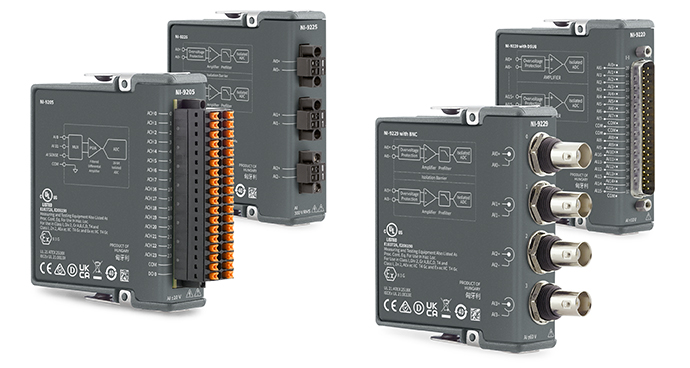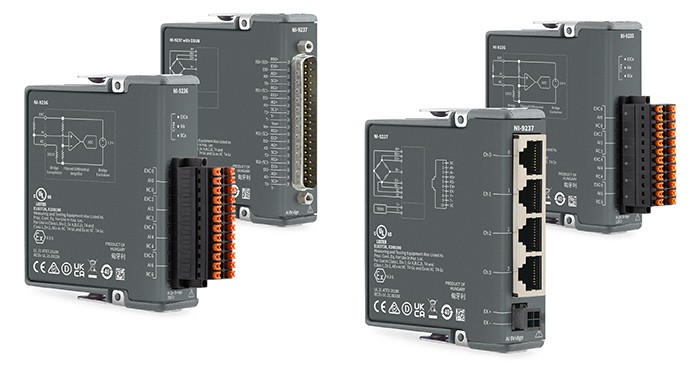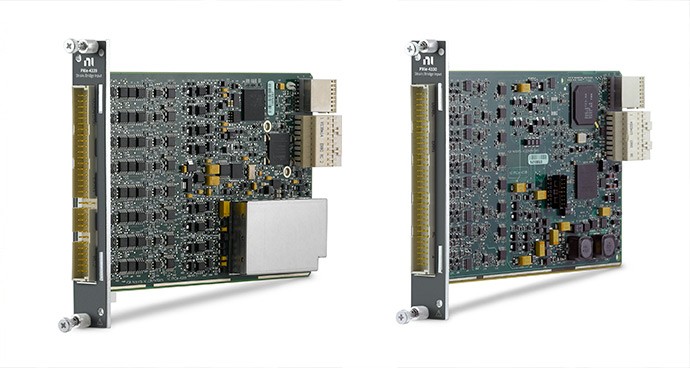Measuring Pressure with Bridge-Based and Other Pressure Sensors
This document provides information to help you understand basic pressure concepts and how different pressure sensors work. You can choose from a variety of sensors, each of which has its own operating principles, benefits, considerations, and drawbacks. After you decide on your sensors, you can consider the required hardware and software to properly condition, acquire, and visualize microphone measurements, then you can also consider any extra signal conditioning you may need.
What Is Pressure
Pressure is defined as force per unit area that a fluid exerts on its surroundings. Pressure, P, is a function of force, F, and area, A:
P = F/A
The SI unit for measuring pressure is the pascal (N/m2), but other common units of pressure include pounds per square inch (psi), atmospheres (atm), bars, inches of mercury (in. Hg), millimeters of mercury (mm Hg), and torr.
A container full of gas contains innumerable atoms and molecules that are constantly bouncing off its walls. The pressure would be the average force of these atoms and molecules on its walls per unit of area of the container. Moreover, pressure does not have to be measured along the wall of a container but rather can be measured as the force per unit area along any plane. Air pressure, for example, is a function of the weight of the air pushing down on Earth. Thus, as the altitude increases, pressure decreases. Similarly, as a scuba diver or submarine dives deeper into the ocean, the pressure increases.
A pressure measurement can be described as either static or dynamic. The pressure in cases with no motion is static pressure. Examples of static pressure include the pressure of the air inside a balloon or water inside a basin. Often, the motion of a fluid changes the force applied to its surroundings. For example, say the pressure of water in a hose with the nozzle closed is 40 pounds per square inch (force per unit area). If you open the nozzle, the pressure drops to a lower value as the water exits the hose. A thorough pressure measurement must note the circumstances under which it is made. Many factors including flow, compressibility of the fluid, and external forces can affect pressure.
Measuring Pressure
While commonly measured in Pascals (Pa), a pressure measurement can further be described by the type of measurement being performed. The three methods for measuring pressure are absolute, gauge, and differential. Absolute pressure is referenced to the pressure in a vacuum, whereas gauge and differential pressures are referenced to another pressure such as the ambient atmospheric pressure or pressure in an adjacent vessel.
Absolute Pressure
The absolute measurement method is relative to 0 Pa, the static pressure in a vacuum. The pressure being measured is acted upon by atmospheric pressure in addition to the pressure of interest. Therefore, absolute pressure measurement includes the effects of atmospheric pressure. This type of measurement is well-suited for atmospheric pressures such as those used in altimeters or vacuum pressures. Often, the abbreviations Paa (Pascal’s absolute) or psia (pounds per square inch absolute) are used to describe absolute pressure.
Gauge Pressure
Gauge pressure is measured relative to ambient atmospheric pressure. This means that both the reference and the pressure of interest are acted upon by atmospheric pressures. Therefore, gauge pressure measurement excludes the effects of atmospheric pressure. These types of measurements include tire pressure and blood pressure measurements. Similar to absolute pressure, the abbreviations Pag (Pascal’s gauge) or psig (pounds per square inch gauge) are used to describe gauge pressure.
Differential Pressure
Differential pressure is similar to gauge pressure; however, the reference is another pressure point in the system rather than the ambient atmospheric pressure. You can use this method to maintain relative pressure between two vessels such as a compressor tank and an associated feed line. Also, the abbreviations Pad (Pascal’s differential) or psid (pounds per square inch differential) are used to describe differential pressure.
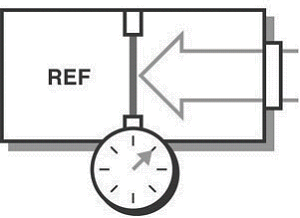
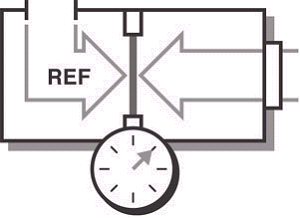
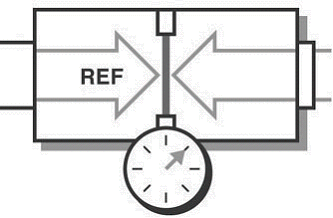
Choosing the Right Pressure Sensor
Different measurement conditions, ranges, and materials used in the construction of a sensor lead to a variety of pressure sensor designs. Often you can convert pressure to some intermediate form, such as displacement, by detecting the amount of deflection on a diaphragm positioned in line with the fluid. The sensor then converts this displacement into an electrical output such as voltage or current. Given the known area of the diaphragm, you can then calculate pressure. Pressure sensors are packaged with a scale that provides a method to convert to engineering units.
The three most universal types of pressure transducers are the bridge (strain gage based), variable capacitance, and piezoelectric.
Bridge-Based Sensors
Bridge-based sensors operate by correlating a physical phenomena, like pressure, to a change in resistance in one or more legs of a Wheatstone bridge. They are the most common type of sensor because they offer solutions that meet varying accuracy, size, ruggedness, and cost constraints. Bridge-based sensors can measure absolute, gauge, or differential pressure in both high- and low-pressure applications. They use a strain gage to detect the deformity of a diaphragm subjected to the applied pressure.
When a change in pressure causes the diaphragm to deflect, a corresponding change in resistance is induced on the strain gage, which you can measure with a conditioned DAQ system. You can bond foil strain gages directly to a diaphragm or to an element that is connected mechanically to the diaphragm. Silicon strain gages are sometimes used as well. For this method, you etch resistors on a silicon-based substrate and use transmission fluid to transmit the pressure from the diaphragm to the substrate.
Because of the simple construction and durability these sensors are lower cost and makes them ideal for higher channel systems. In general, foil strain gages are used in high-pressure (up to 700M Pa) applications. They also have a higher operating temperature than silicon strain gages (200 °C versus 100 °C, respectively), but silicon strain gages offer the benefit of larger overload capability. Because they are more sensitive, silicon strain gages are also often preferred in low-pressure applications (~2k Pa).
Capacitive Pressure and Piezoelectric Sensors
A variable capacitance pressure transducer measures the change in capacitance between a metal diaphragm and a fixed metal plate. The capacitance between two metal plates changes if the distance between these two plates changes due to applied pressure.
Piezoelectric sensors rely on the electrical properties of quartz crystals rather than a resistive bridge transducer. These crystals generate an electrical charge when they are strained. Electrodes transfer the charge from the crystals to an amplifier built into the sensor. These sensors do not require an external excitation source, but they are susceptible to shock and vibration.
Capacitive and piezoelectric pressure transducers are generally stable and linear, but they are sensitive to high temperatures and are more complicated to set up than most pressure sensors. Piezoelectric sensors respond quickly to pressure changes. For this reason, they are used to make rapid pressure measurements from events such as explosions. Because of their superior dynamic performance, piezoelectric sensors are the least cost-effective, and you must be careful to protect their sensitive crystal core.
Conditioned Pressure Sensors
Sensors that include integrated circuitry, such as amplifiers, are referred to as amplified sensors. These types of sensors may be constructed using bridge-based, capacitive, or piezoelectric transducers. In the case of a bridge-based amplified sensor, the unit itself provides completion resistors and the amplification necessary to measure the pressure directly with a DAQ device. Though excitation must still be provided, the accuracy of the excitation is less important.
Conditioned sensors are typically more expensive because they contain components for filtering and signal amplification, excitation leads, and the regular circuitry for measurement. This is helpful for lower channel systems that do not warrant a dedicated signal conditioning system. Because the conditioning is built in, you can connect the sensor directly to a DAQ device as long as you provide power to the sensor in some way. If you are working with nonconditioned pressure bridge-based sensors, your hardware needs signal conditioning. Check the sensor’s documentation so that you know whether you need additional components for amplification or filtering.
![Figure 1. Cross Section of a Typical Bridge-Based Pressure Sensor [1]](https://ni.scene7.com/is/image/ni/Bridge_based_pressure_20160524175742?fmt=png-alpha&scl=1)
![Figure 2. Capacitance Pressure Transducer [2]](https://ni.scene7.com/is/image/ni/image1558139866309153888?fmt=png-alpha&scl=1)
![Figure 3. Piezoelectric Pressure Transducer [2]](https://ni.scene7.com/is/image/ni/image6689574097768183094?fmt=png-alpha&scl=1)
Signal Conditioning for Pressure Sensor
Bridge-based pressure sensors are by far the most common pressure sensors. You need to consider several signal conditioning elements to make an effective bridge-based pressure measurement system. You may need one or more of the following things:
- Excitation to power the Wheatstone bridge circuitry
- Remote sensing to compensate for errors in excitation voltage from long lead wires
- Amplification to increase measurement resolution and improve signal-to-noise ratio
- Filtering to remove external, high-frequency noise
- Offset nulling to balance the bridge to output 0 V when no strain is applied
- Shunt calibration to verify the output of the bridge to a known, expected value
To learn how to compensate for these errors and review other hardware considerations for bridge-based pressure measurements, download the Engineer's Guide to Accurate Sensor Measurements.
Connecting Pressure Sensors to NI Hardware
After you know your sensor or test needs, deciding on the hardware to collect that data is the next important step. The acquisition hardware quality determines the quality of the data you collect.
Pressure sensors can connect to a variety of NI hardware depending on the type of pressure sensors. For example, for voltage-output pressure sensors, a C Series Voltage Input Module, which can be part of a CompactDAQ or CompactRIO system, can work; or, for a bridge-based pressure sensor, you can connect them to NI’s strain/bridge modules and devices.
Simple Hardware Setup
Pair Pressure Sensors with Recommended NI Hardware
The CompactDAQ Strain and Load Bundle simplifies connecting your bridge-based pressure sensor with a bundle of strain/bridge input module(s) and a CompactDAQ chassis.
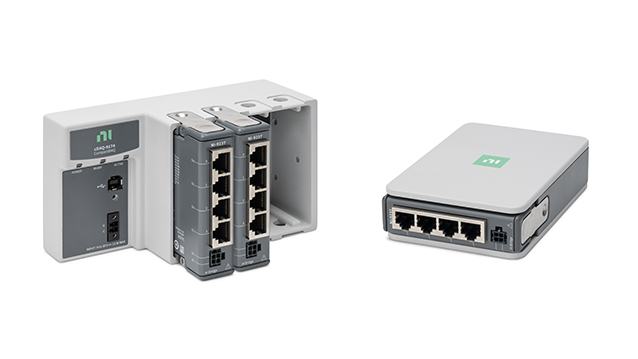
Other Products for Measuring Pressure
The following products interface with pressure sensors to acquire pressure signals. You can use these products to excite, condition, acquire, and digitize measurements. Some of these devices also work for strain, load, and torque measurements as well. Learn more about measuring strain with strain gauges as well as measuring load and torque bridge-based sensors to pair with NI products.
References
- [1] Johnson, Curtis D, “Pressure Principles,” Process Control Instrumentation Technology, Prentice Hall PTB.
- [2] Daytronic.com, “Strain Gauge Pressure Transducers”. Sensotec.com, “Honeywell Sensotec Frequently Asked Questions,” http://www.sensotec.com/pdf/FAQ_092003.pdf (current November 2003).
- Sensotec.com, “Honeywell Sensotec Frequently Asked Questions,” http://www.sensotec.com/pdf/FAQ_092003.pdf (current November 2003).
- Sensorsmag.com, “Pressure Measurement: Principles and Practice,” http://www.sensorsmag.com/articles/0103/19/main.shtml (current January 2003).
